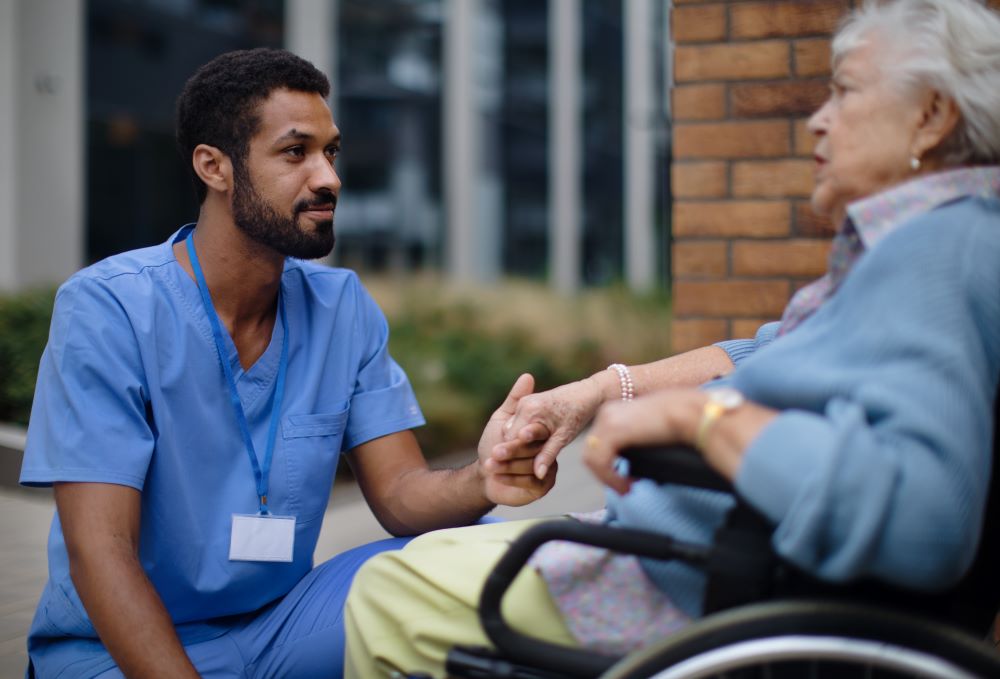Safeguarding is an essential framework designed to protect society’s most vulnerable individuals.
This article will explore the core principles, prevention of harm, and the legal obligations that underpin safety within care environments.
What is Safeguarding in Care?
Safeguarding means protecting individuals’ health, wellbeing, and human rights from harm, abuse, and neglect.
It is essential in providing quality health and social care and ensures collective responsibility to protect vulnerable individuals.
The core of safeguarding is its proactive approach. It aims to ensure safety procedures are followed when working with vulnerable people.
In care settings, safeguarding means taking all necessary measures to prevent harm and promote well-being.
High-quality care is deeply intertwined with safeguarding, which is integral to the care of children, young people, and adults at risk.
Safeguarding responsibilities cut across all staff in various care settings, such as:
Hospitals
Care homes
General practices
Community care
Disability support services

Defining Vulnerable Groups
In health and social care, vulnerable people are any individuals who may need additional support or protection due to various factors. These can include:
Children and young people
Adults receiving care at home
Elderly people
Individuals with mental health challenges
People with disabilities
Whether public, private, or nonprofit, every sector bears the responsibility of safeguarding these vulnerable people.
It’s also worth noting that people with disabilities may face additional safeguarding risks due to potential systemic failures in upholding their rights.

Types of Harm Prevented by Safeguarding
Safeguarding efforts aim to address various forms of abuse and neglect. These include:
Physical abuse
Emotional harm
Sexual abuse
Financial exploitation
Neglect
Physical abuse
Discriminatory abuse
Legal Foundations of Safeguarding in the UK
In the UK, safeguarding is a legal requirement.
The legal framework includes notable legislations such as:
Care Act 2014: This act establishes a framework for adult social care in England, setting out local authorities’ duties to assess and meet the care and support needs of adults and their carers.
Children Act 1989: This pivotal statute in the UK’s child welfare system provides the legal structure for safeguarding children from harm, highlighting the importance of children’s needs and specifying the duties of parents and local authorities in fulfilling those needs.
Children and Social Work Act 2017: This act aims to improve support for looked-after children, promote the welfare and safeguarding of children, and enhance the regulation of social work professionals in England.
Safeguarding Vulnerable Groups Act 2006: Introduced to prevent unsuitable individuals from working with children and vulnerable adults, this act established a vetting system for those seeking to engage in regulated activities with these groups.
Additionally, the Data Protection Act ensures the secure handling of sensitive information related to these individuals.
The Role of Local Authorities and Safeguarding Adults Board
Local authorities play a crucial role in safeguarding, responsible for implementing safeguarding duties and procedures, coordinating care, and advancing community health and well-being.
Moreover, if a local authority suspects an individual might be in need of safeguarding, they are responsible for assessing them.
Working hand in hand with local authorities is the Safeguarding Adults Board, which ensures the effectiveness of safeguarding services for adults at risk by coordinating local agencies.
The Six Principles of Safeguarding
The safeguarding framework adheres to six principles established by the Care Act 2014 and outlined by the Department of Health.
These principles are:
Empowerment: Individuals are encouraged and supported to make their own decisions and give informed consent. This principle prioritises the person’s voice in the safeguarding process, ensuring they have control over their lives and care.
Prevention: It is better to take action before harm occurs. This principle focuses on preventing abuse and neglect by identifying risks early and offering proactive support to reduce the likelihood of harm.
Proportionality: The response to any child or adult safeguarding issue should be appropriate to the level of risk and seriousness of the outcome. This means not overreacting to minor concerns but taking firm action when serious risks are identified, ensuring the least intrusive response appropriate to the risk presented.
Protection: Support and representation for those in greatest need. This principle emphasises the need to provide help and support to those who are at risk of abuse or neglect, ensuring they receive the protection they need to feel safe.
Partnership: Local services must work together with their communities. Safeguarding is a shared responsibility, requiring effective collaboration between different sectors and services to protect children and vulnerable adults.
Accountability: This final principle stresses the importance of accountability and transparency among all involved in the safeguarding process. Everyone should understand their roles and responsibilities, with clear reporting and communication channels to ensure actions are taken appropriately and effectively.
Together, these principles form a framework that ensures safeguarding practice is carried out in a way that respects the rights and needs of individuals, promoting safety, health, and well-being.

Recognising the Signs of Abuse and Neglect
Abuse can manifest in various forms, including physical, emotional, sexual, and financial, while neglect refers to the failure to meet a person’s basic needs. Here are key indicators to watch for:
Physical Abuse: Look for unexplained bruises, burns, or injuries. Frequent, unexplained accidents or injuries that don’t match the given explanation can also be a red flag.
Emotional Abuse: Signs include sudden changes in behaviour or confidence, uncooperative or withdrawn behaviour, low self-esteem, difficulty with sleep, and fearfulness around certain individuals. Victims may also show signs of depression or anxiety.
Sexual Abuse: Indications can include unexplained changes in behaviour or knowledge about sexual matters inappropriate for their age, difficulty walking or sitting, physical symptoms such as pain or bleeding, or the presence of sexually transmitted infections.
Financial Abuse: Be alert to sudden changes in financial situations, such as changes in wills or power of attorney, distress about finances, sudden inability to afford basic items, and missing personal belongings.
Neglect: Signs include poor hygiene, unattended medical needs, consistent hunger, weight loss, and inappropriate or insufficient clothing. A person living in unsanitary or unsafe living conditions may also be experiencing neglect.
Recognising these signs is the first step in taking action to protect those at risk.
It’s important to approach the situation with sensitivity and follow the proper channels to report your observations and concerns. This ensures that any potential abuse or neglect is addressed promptly and appropriately, safeguarding the well-being of those in their care.
Reporting Concerns
Once signs of abuse or neglect are recognised, it’s crucial to report any incidents without delay to initiate the safeguarding process.
Prompt reporting is vital as it activates further investigative steps, paving the way for the necessary protection of vulnerable individuals.
The Safeguarding Procedure Explained
The safeguarding procedure is a carefully structured approach designed to ensure the safety and well-being of vulnerable individuals. It begins with the recognition and reporting of concerns and progresses through assessment, investigation, and the implementation of protection plans.
Here’s a closer look at each step in the process:
Immediate Action and Reporting Concerns
Quick and appropriate action is essential when responding to a safeguarding incident, prioritising the immediate safety and support of the person involved.
The safeguarding process starts when a concern about potential abuse or neglect is identified and reported.
In care settings, anyone—staff, family members, the individuals themselves, or other professionals—can raise a safeguarding concern.
These reports should made without delay, following the specific protocols established within the organisation, to ensure the concern is quickly addressed.
Assessments and Investigations
Once a concern is reported, an initial assessment is conducted to determine the level of risk and the immediate needs of the individual involved.
This may involve professionals from health care, social services, or safeguarding teams who work together to gather information and assess the situation.
If the concern warrants further investigation, a more detailed inquiry is launched to understand the nature and extent of the abuse or neglect, gather evidence, and decide on the appropriate course of action.
Incident reporting systems can be employed to view incidents in real-time, immediately mitigate consequences, and analyse reports to identify trends and risks.
Implementing Safeguarding Plans
Based on the findings of the assessment and investigation, a tailored protection plan is developed to address the specific needs and risks identified.
Following an inquiry or assessment, a safeguarding plan details the necessary future action, additional support or treatment required, and prevention strategies for managing further risk.
This plan may include interventions such as moving the individual to a safer environment, providing medical or psychological support, or implementing measures to prevent further abuse.
The plan is regularly reviewed and updated as necessary to ensure ongoing protection and support for the individual. Reviewing a Safeguarding Plan involves:
Evaluating its effectiveness
Ensuring it continues to be relevant to the individual’s needs
Making any necessary changes, including the possibility to conclude the plan.
Training and Education in Safeguarding

Education and training are the bedrock of effective safeguarding.
Staff in care settings need adequate training to:
Prevent accidental neglect or mistreatment
Recognise signs of abuse and neglect
Understand legal and ethical considerations
Know appropriate responses
Safeguarding training is a mandatory part of the induction process for new staff and must be regularly updated to stay current with legal developments and evolving best practices.
Regular, in-depth training sessions should use real-life scenarios and case studies to illustrate signs and symptoms. This makes it easier for staff to understand and recognise them in their daily work, thus increasing confidence in handling such situations.
This ongoing education is crucial to ensure staff are well-prepared to act as the first line of defence in protecting vulnerable people. Training empowers staff not just to recognise signs of abuse, but also to respond swiftly and appropriately, ensuring the safety and well-being of those in their care.
The Role of Technology in Safeguarding
In the digital age, technology plays a crucial role in enhancing safeguarding efforts.
A digital incident reporting system can significantly improve communication and record-keeping, which are vital components in safeguarding vulnerable individuals.
Vatix’s incident reporting platform can notably streamline the safeguarding reporting and management process and ensure that incidents are dealt with more efficiently and effectively.
Real-time reporting: Allows staff to report incidents directly from their mobile devices, increasing both the amount of incidents reported and the likelihood of timely reports.
Automated notifications: Immediate alerts are sent to relevant staff upon submission of a report, enabling quicker response times to safeguarding incidents.
Centralised data management: Keeps all data regarding safeguarding incidents in one secure place, making it easy to access and manage.
Customisable forms: Tailor safeguarding reporting forms to meet the specific needs of different care settings.
Comprehensive analytics dashboards: Provides tailored insights into trend analysis, helping to identify potential risk factors or vulnerabilities within the care setting. This enables organisations to make data-driven decisions and preventive actions to protect vulnerable individuals efficiently.
Summary
Safeguarding in health and social care is a multifaceted responsibility that requires comprehensive understanding, vigilance, and appropriate action.
It’s a dynamic process that involves recognising signs of abuse and neglect, understanding the legal framework, having an efficient reporting system, implementing safeguarding procedures, and equipping staff with necessary training.
For more information on how our safeguarding reporting platform can assist in protecting those under your care, get in touch with our sales team here.

